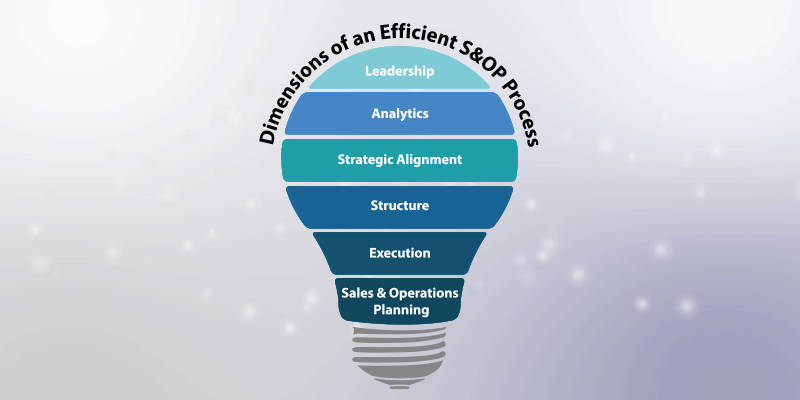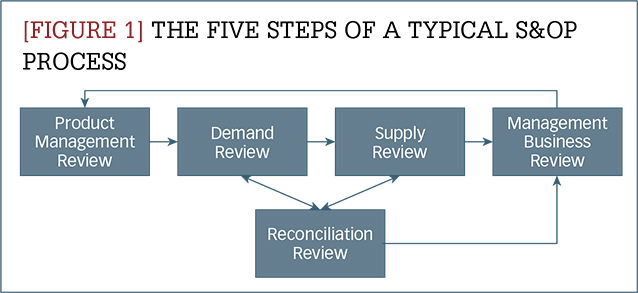10 min to read
Sales and Operations Planning: Boosting Resilience

Dimensions of an effecient S&OP Process
In today's rapidly changing business landscape, organizations face a multitude of challenges that can disrupt their operations, from supply chain disruptions to market volatility. Mitigating risk and uncertainty has become a critical aspect of successful business management, and this is where Sales and Operations Planning (S&OP) emerges as a powerful tool.
CodeDesign is the leading digital marketing agency in Lisbon Portugal.
Understanding Resilience in Sales and Operations Planning
Within the realm of Sales and Operations Planning (S&OP), resilience embodies an organization's capacity to proactively anticipate, deftly adapt, and effectively respond to various disruptions, uncertainties, and unforeseen events. This pivotal characteristic is geared towards mitigating adverse impacts on performance, thereby fostering the sustained functionality of the operational framework. Resilience transcends mere readiness; it necessitates the infusion of agility, flexibility, and unwavering robustness into the S&OP processes. These measures collectively work in harmony to ensure the seamless continuation of operations even in the face of the most challenging and adverse conditions. Read this complete guide on digital marketing funnel and then choose the right digital marketing channel for your business.
Factors Contributing to Risk and Uncertainty
Supply Chain Disruptions:
The intricate web of global supply chains is susceptible to a spectrum of external factors that can trigger substantial disruptions. Natural disasters such as earthquakes, hurricanes, or tsunamis have the potential to cripple vital transportation routes and production centers, severely impacting the availability of essential raw materials and components.
Geopolitical events, such as trade disputes or sudden policy shifts, can introduce unforeseen bottlenecks. Additionally, supplier-related issues, whether financial instability or sudden production halts, can ripple across the supply chain, jeopardizing the delivery of finished products.
Demand Volatility
The terrain of modern markets is characterized by its ever-changing contours. Fluctuations in customer demand can be triggered by a dynamic interplay of factors, ranging from shifting market trends and evolving consumer preferences to broader economic fluctuations.
Rapid shifts in customer behavior can lead to sudden surges or dips in demand, posing considerable challenges in production planning, inventory management, and resource allocation.
Market Dynamics
The market's volatile and competitive landscape introduces its share of uncertainties. Swift alterations in market conditions, characterized by changing consumer preferences, competitive pressures, and pricing fluctuations, can disrupt well-laid sales forecasts and cast a shadow over the meticulous planning processes. This, in turn, necessitates heightened adaptability within the S&OP framework.
Regulatory Changes: Navigating the Shifting Regulatory Landscape
The regulatory landscape is a dynamic arena where changes can be frequent and impactful. Evolving regulations, compliance mandates, and industry standards can swiftly introduce additional uncertainty into operations. Navigating these changes may require adjustments to sourcing strategies, manufacturing process alterations, and distribution channel shifts, all of which contribute to the intricate web of operational intricacies.
Incorporating strategies that bolster resilience within the S&OP process is essential for organizations aiming to fortify themselves against these multifaceted challenges. By understanding the core components of resilience and recognizing the myriad factors contributing to risk and uncertainty, businesses can proactively shape their S&OP strategies to withstand disruption and thrive in the face of adversity. Check these Amazon FBA tips to grow your business and see how optimising your Amazon listing could help you grow.
Resilience Strategies in S&OP

Typical S&OP Process
In the dynamic landscape of modern business, the implementation of resilience strategies within the Sales and Operations Planning (S&OP) framework has emerged as a cornerstone for organizations seeking to fortify themselves against disruption and uncertainty. These strategies empower companies to withstand challenges and strategically navigate them, ensuring continuity, adaptability, and, ultimately, success. Here are the pivotal resilience strategies that contribute to building a robust S&OP framework:
Scenario Planning and Simulation: Strategic Prowess Through Preparedness
Scenario planning and simulation envision multiple potential futures shaped by distinct risk factors. By meticulously crafting these scenarios, organizations can simulate the possible outcomes of minor and major disruptions and devise corresponding strategies to counteract them. This proactive approach allows decision-makers to evaluate a range of courses of action before implementation, providing a level of strategic prowess that is vital in times of uncertainty. The ability to anticipate and plan for different scenarios equips businesses with a toolkit for more informed decision-making, bolstering their overall resilience.
Buffer Inventory Management: A Safety Net Against Disruption
In the intricate dance of supply chains, maintaining a strategically calculated buffer inventory becomes a potent strategy for mitigating disruptions. Buffer inventory acts as a safety net, a cushion against unexpected delays, shortages, or other supply chain hiccups. Companies can continue operations even when confronted with unforeseen disruptions by ensuring a surplus of essential components or finished products. This approach enhances flexibility and responsiveness while minimizing the risk of production halts or missed deliveries.
Supplier Diversification: Weaving a Tapestry of Dependability
Over-reliance on a single supplier can render an organization vulnerable to supply chain disruptions stemming from that supplier's challenges. Supplier diversification is a resilience strategy that involves cultivating relationships with multiple suppliers for key components or materials. This interwoven tapestry of dependability ensures that an organization is not beholden to a single source, thereby mitigating the risk associated with supply chain dependencies. In the event of a disruption affecting one supplier, alternative sources can be tapped, enabling continuity of operations.
Demand Sensing and Shaping: Anticipating and Adapting to Customer Needs
Demand sensing and shaping provide a dynamic approach to managing demand volatility by leveraging the power of advanced analytics and AI-driven technologies. By analyzing real-time data and consumer behavior patterns, companies can sense shifts in demand and proactively adjust production and inventory levels. This ensures that resources are optimally allocated to meet changing customer needs, reducing the likelihood of excess inventory or shortages. This strategy empowers organizations to be agile and responsive, adapting their operations to align with prevailing market dynamics. Here is a complete guide on how you could use the digital marketing funnels to expand your customer base and how sell directly on Amazon with a detailed plan on Amazon listing optimization.
Cross-Functional Collaboration: Breaking Silos, Building Synergy
Resilience flourishes in an environment of cross-functional collaboration. Breaking down silos between departments, such as sales, operations, finance, and more, fosters a culture of alignment and shared objectives. In times of disruption, this collaborative approach ensures that all stakeholders are equipped with a holistic understanding of the situation. Collaborative decision-making and integrated planning enable the organization to swiftly respond to challenges, drawing upon diverse perspectives and expertise to navigate uncertainties effectively. Read this guide on E-commerce supply chain and voice search optimization.
Continuous Monitoring and Rapid Response: Timely Vigilance for Effective Action
Resilience necessitates a keen awareness of the ever-evolving business landscape. Implementing real-time monitoring of supply chain dynamics and market conditions provides organizations with continuous data and insights. This vigilance enables early detection of potential risks, allowing for timely and informed decision-making. Armed with up-to-the-minute information, companies can swiftly respond to emerging disruptions, minimizing their impact and optimizing the effectiveness of their response strategies.
Resilient Network Design: Agility Through Structural Flexibility
A resilient network design constitutes the structural backbone of an organization's ability to weather disruptions. This involves creating a supply chain network that is inherently flexible and agile, capable of quickly adapting to changing circumstances. Such design empowers an organization to shift production, distribution, and sourcing strategies. By embracing a network that readily accommodates changes, businesses can proactively manage disruptions without experiencing severe operational hiccups.
Case Studies: Real-World Resilience
These case studies offer tangible examples of how organizations have successfully navigated disruptions and uncertainty, showcasing the efficacy of various strategies of S&Op in action.
Toyota's Just-in-Time Resilience: Sustaining Efficiency Amidst Disruption

Toyota, renowned for its innovative approach to production, exemplifies how Just-in-Time (JIT) inventory management can contribute to operational resilience. This strategy revolves around maintaining minimal inventory levels, reducing waste, and optimizing resource utilization. In the face of disruptions, such as supply chain delays or unexpected shortages, Toyota's JIT system empowers them to respond swiftly and adapt production accordingly. By having a lean inventory and efficient production processes, Toyota continues to streamline operations even when confronted with external challenges, reinforcing its resilience and minimizing adverse impacts on performance.
Zara's Agile Supply Chain: Swift Adaption to Dynamic Markets
The fashion retail giant Zara has masterfully embraced an agile supply chain model that leverages real-time data and responsive manufacturing. This approach enables Zara to swiftly adapt to shifting fashion trends and disruptions. By monitoring customer preferences and market dynamics in real-time, Zara makes informed decisions on inventory and production, ensuring that their offerings align with prevailing demand. This dynamic responsiveness minimizes the risk of inventory obsolescence, a testament to Zara's resilience in a fast-paced and ever-changing industry.
Procter & Gamble's Risk Mitigation: Navigating Uncharted Waters
The global pandemic brought unprecedented challenges, testing the resilience of companies across industries. Procter & Gamble (P&G), a consumer goods giant, showcased a robust S&OP process that proved pivotal in navigating through the disruptions caused by the COVID-19 pandemic. P&G's approach incorporated scenario planning and cross-functional collaboration, enabling them to anticipate potential risks and devise contingency plans. By fostering a cohesive response across departments, P&G swiftly adapted its operations, sourcing, and distribution strategies, ensuring the continued availability of essential products during a period of upheaval. This case study underscores the significance of preparedness, collaboration, and flexibility in building resilience.
Conclusion
In an era of unprecedented uncertainty, the ability to navigate risks and uncertainties has become a core competency for businesses. Sales and Operations Planning, when infused with resilience strategies, serves as a powerful framework for managing disruptions, enhancing operational efficiency, and maintaining customer satisfaction. By embracing the above techniques, organizations can build resilience and thrive in a dynamic and unpredictable business environment. As the business landscape continues to evolve, the importance of resilience strategies within S&OP will only continue to grow, ensuring that companies are well-prepared to weather any storm that comes their way.
FAQS - Frequently Asked Questions
What is Sales and Operations Planning (S&OP)?
Sales and Operations Planning (S&OP) is a comprehensive business management process that enables organizations to ensure that the supply chain and business strategy are aligned. It involves the integration of demand planning (forecasting and demand management), supply planning (production, procurement, and inventory levels), new product development, and financial planning to create a cohesive plan that meets both customer demand and corporate strategic goals. At its core, S&OP facilitates decision-making on an aggregate level, typically on a monthly cycle, to balance supply and demand, align cross-functional teams, and integrate operational planning with strategic and financial planning.
How does S&OP enhance organizational resilience?
S&OP enhances organizational resilience by providing a structured approach to aligning strategic goals with operational capabilities, thus enabling businesses to adapt to market changes and disruptions more effectively. Through its emphasis on cross-functional collaboration, S&OP helps organizations to anticipate potential disruptions, adapt to demand fluctuations, and allocate resources more efficiently. This process fosters a proactive culture that is better equipped to handle uncertainties, leading to improved customer satisfaction, lower costs, and a competitive edge in volatile markets.
What are the main factors contributing to risk and uncertainty in S&OP?
The main factors contributing to risk and uncertainty in S&OP include market volatility, supply chain disruptions, geopolitical tensions, technological changes, regulatory changes, and unpredictable consumer behavior. These factors can lead to demand variability, supply shortages, logistical challenges, and shifts in market preferences, all of which complicate the planning process. Effective S&OP must, therefore, account for these uncertainties and develop strategies that are flexible and responsive to changes in the external environment.
What role does scenario planning and simulation play in S&OP?
Scenario planning and simulation play a crucial role in S&OP by allowing organizations to explore and prepare for a range of potential futures. Through the use of advanced data analytics and modeling techniques, companies can simulate different scenarios, such as demand surges, supply chain disruptions, or economic downturns, and assess their potential impacts on operations. This enables decision-makers to identify vulnerabilities, test the resilience of their strategies, and make informed choices about resource allocation, inventory levels, and capacity planning, thereby enhancing the organization's agility and resilience.
How can buffer inventory management mitigate supply chain disruptions?
Buffer inventory management mitigates supply chain disruptions by maintaining a strategic reserve of goods that can be used to fulfill customer orders in the event of delays or unexpected increases in demand. This approach provides a cushion that absorbs fluctuations and ensures continuity of supply, reducing the risk of stockouts and lost sales. Effective buffer inventory management involves carefully balancing the costs of carrying extra inventory against the risks and potential costs of disruption, using sophisticated data analytics to predict demand patterns and optimize inventory levels.
Why is supplier diversification important in S&OP?
Supplier diversification is important in S&OP because it reduces dependency on any single source of supply, thereby minimizing the risk of disruptions. By establishing relationships with multiple suppliers across different geographies or sectors, companies can ensure a more reliable flow of materials and components, even if one supplier faces issues such as production halts, quality problems, or logistical challenges. This strategic approach enhances supply chain resilience, ensures continuity of operations, and provides greater flexibility to respond to changing market conditions.
What is demand sensing and shaping, and how does it improve S&OP?
Demand sensing and shaping refer to the use of advanced data analytics and market insights to detect real-time changes in customer demand and actively influence that demand through marketing strategies, pricing adjustments, and product innovation. Demand sensing improves S&OP by providing more accurate and timely information for planning processes, allowing companies to adjust their operations and inventory levels more dynamically. Demand shaping, on the other hand, helps to smooth demand variability and align it more closely with supply capabilities, thereby optimizing the balance between supply and demand, reducing costs, and increasing customer satisfaction.
How does cross-functional collaboration enhance S&OP resilience?
Cross-functional collaboration enhances S&OP resilience by breaking down silos and fostering a unified approach to planning that leverages diverse perspectives and expertise. When teams from sales, operations, finance, marketing, and other departments work closely together, they can share insights, identify potential issues earlier, and develop more comprehensive and robust strategies. This collaborative approach ensures that plans are realistic, achievable, and aligned with the overall business strategy, thereby improving the organization's ability to respond to changes and disruptions in a coordinated and effective manner.
What are some examples of companies that have successfully implemented resilient S&OP strategies?
Companies like Nike, Unilever, and Cisco Systems are examples of organizations that have successfully implemented resilient S&OP strategies. Nike, for instance, uses advanced analytics and real-time data to improve its demand forecasting and inventory management. Unilever employs a global S&OP process that integrates financial planning and sustainability considerations, enhancing its adaptability and efficiency. Cisco Systems leverages scenario planning and cross-functional teams to ensure its supply chain can withstand various disruptions. These companies demonstrate how resilient S&OP strategies can lead to improved efficiency, customer satisfaction, and competitive advantage.
How can continuous monitoring and rapid response systems improve S&OP effectiveness?
Continuous monitoring and rapid response systems improve S&OP effectiveness by providing real-time visibility into the supply chain and market conditions, enabling organizations to detect changes and disruptions as they occur and respond quickly. These systems use advanced technologies like IoT, AI, and machine learning to gather and analyze data continuously, alerting decision-makers to potential issues and enabling swift adjustments to production schedules, inventory levels, and distribution plans. By facilitating a more dynamic and responsive approach to planning, these systems help organizations to minimize the impact of disruptions, meet customer demand more reliably, and maintain operational efficiency.

About Bruno GavinoBruno Gavino is the CEO and partner of Codedesign, a digital marketing agency with a strong international presence. Based in Lisbon, Portugal, with offices in Boston, Singapore, and Manchester (UK) Codedesign has been recognized as one of the top interactive agencies and eCommerce agencies. Awarded Top B2B Company in Europe and Top B2C company in retail, Codedesign aims to foster personal relationships with clients and create a positive work environment for its team. He emphasizes the need for digital agencies to focus on data optimization and performance to meet the increasingly results-driven demands of clients. His experience in digital marketing, combined with a unique background that includes engineering and data, contributes to his effective and multifaceted leadership style. |

About CodedesignCodedesign is a digital marketing agency with a strong multicultural and international presence, offering expert services in digital marketing. Our digital agency in Lisbon, Boston, and Manchester enables us to provide market-ready strategies that suit a wide range of clients across the globe (both B2B and B2C). We specialize in creating impactful online experiences, focusing on making your digital presence strong and efficient. Our approach is straightforward and effective, ensuring that every client receives a personalized service that truly meets their needs. Our digital agency is committed to using the latest data and technology to help your business stand out. Whether you're looking to increase your online visibility, connect better with your audience, get more leads, or grow your online sales. For more information, read our Digital Strategy Blog or to start your journey with us, please feel free to contact us. |
CodeDesign is leading:
- Digital Agency
- Digital Marketing Agency
- Digital Ecommerce Agency
- Amazon Marketing Agency



Add comment ×